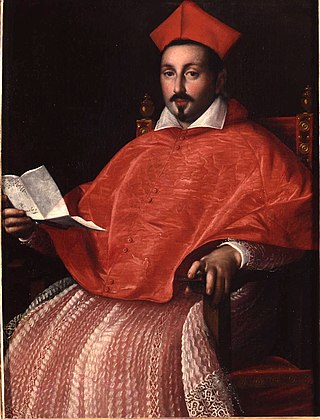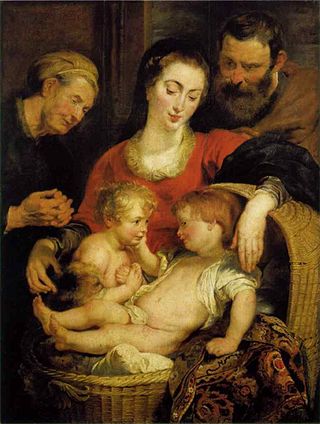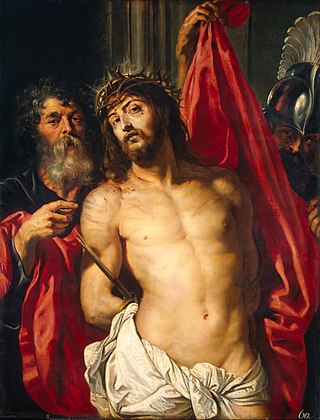
The Galleria Borghese is an art gallery in Rome, Italy, housed in the former Villa Borghese Pinciana. At the outset, the gallery building was integrated with its gardens, but nowadays the Villa Borghese gardens are considered a separate tourist attraction. The Galleria Borghese houses a substantial part of the Borghese Collection of paintings, sculpture and antiquities, begun by Cardinal Scipione Borghese, the nephew of Pope Paul V. The building was constructed by the architect Flaminio Ponzio, developing sketches by Scipione Borghese himself, who used it as a villa suburbana, a country villa at the edge of Rome.

Scipione Borghese was an Italian cardinal, art collector and patron of the arts. A member of the Borghese family, he was the patron of the painter Caravaggio and the artist Bernini. His legacy is the establishment of the art collection at the Villa Borghese in Rome.

The Deposition, also known as the Pala Baglioni, Borghese Entombment or The Entombment, is an oil painting by the Italian High Renaissance painter Raphael. Signed and dated "Raphael. Urbinas. MDVII", the painting is in the Galleria Borghese in Rome. It is the central panel of a larger altarpiece commissioned by Atalanta Baglioni of Perugia in honor of her slain son, Grifonetto Baglioni. Like many works, it shares elements of the common subjects of the Deposition of Christ, the Lamentation of Christ, and the Entombment of Christ. The painting is on wood panel and measures 184 x 176 cm.

David with the Head of Goliath, dated c. 1600-1601, is a painting by the Italian artist Caravaggio (1571–1610), housed in the Kunsthistorisches Museum Gemäldegalerie, Vienna. Peter Robb believes it was acquired by the conde de Villamediana in Naples between 1611 and 1617, as Giovanni Bellori records Villamediana as having returned to Spain with a half-figure of David by Caravaggio.

Portrait of Pope Paul V is a painting attributed to the Italian artist Michelangelo Merisi da Caravaggio (1571–1610), now in the Galleria Borghese, Rome.

The Descent from the Cross is the central panel of a triptych painting by the Baroque artist Peter Paul Rubens in 1612–1614. It is still in its original place, the Cathedral of Our Lady, Antwerp, Belgium. The painting is considered to be one of Rubens' masterpieces. The painting depicts the moment when the body of Jesus Christ is taken down from the cross after his crucifixion. The subject was one Rubens returned to again and again in his career. The artwork was commissioned on September 7, 1611, by the Confraternity of the Arquebusiers, whose patron saint was St. Christopher.
Events from the year 1610 in art.

The Borghese Collection is a collection of Roman sculptures, old masters and modern art collected by the Roman Borghese family, especially Cardinal Scipione Borghese, from the 17th century on. It includes major collections of Caravaggio, Raphael, and Titian, and of ancient Roman art. Cardinal Scipione Borghese also bought widely from leading painters and sculptors of his time, and Scipione Borghese's commissions include two portrait busts by Gian Lorenzo Bernini. Most of the collection remains intact and on display at the Galleria Borghese, although a significant sale of classical sculpture was made under duress to the Louvre in 1807.

Isabella Brant was the first wife of the Flemish painter Peter Paul Rubens, who painted several portraits of her.

Susanna and the Elders is a painting by Flemish artist Peter Paul Rubens from 1607. It is housed in the Galleria Borghese in Rome, Italy. There is another version, a youthful work from 1608, in Real Academia de Bellas Artes de San Fernando, in Madrid.

St Sebastian is a painting of c. 1614 by Peter Paul Rubens, showing the Christian Saint Sebastian. It dates to the early years of Rubens' stay in Rome - its sinuous line and defined figures are thought to be the result of his studies of Michelangelo and of Flemish Mannerism. It was bought by the Borghese directly from cardinal Neri Corsini in Brussels. It is now in the Borghese collection.
Leda and the Swan is a classical myth.

The Madonna of the Basket or the Madonna della Cesta is a painting by Peter Paul Rubens, dated to around 1615. It is now held in the Galleria Palatina of the Palazzo Pitti in Florence. Between 1799 and 1815 it was confiscated by the French and assigned to the Dijon Museum of Fine Arts.

The Four Philosophers is an oil painting on panel painted in 1611–12 by Peter Paul Rubens. It is now held in the Galleria Palatina of the Palazzo Pitti in Florence.

The Resurrection of Christ, The Easter Tomb or The Triumph of Christ over Death and Sin is a painting by Peter Paul Rubens, executed c. 1616. It entered the collection of Ferdinando de' Medici, Grand Prince of Tuscany between 1713 and 1723 and is now in the Galleria Palatina of the Palazzo Pitti in Florence.

The Peasants' Return From The Fields is a c. 1640 painting by Peter Paul Rubens. It arrived in Florence in 1765 and is now in the Galleria Palatina in Florence.

The Three Graces is a grisaille painting by Peter Paul Rubens, dating to 1620–1623. It is now held in the Galleria Palatina in Florence.

Mariano Rossi was an Italian painter, persisting in what had become an anachronistic Rococo style amid an ascendant neoclassical environment. His placement legions of figures in a complex scenography and quadrature recalls the work of Pietro da Cortona.

Ecce Homo or Christ Wearing the Crown of Thorns is an oil on oak panel painting of the Ecce Homo subject by Peter Paul Rubens, executed c. 1612, now in the Hermitage Museum, in Saint Petersburg. The Hermitage also houses an oil study for its figure of Pilate.

















